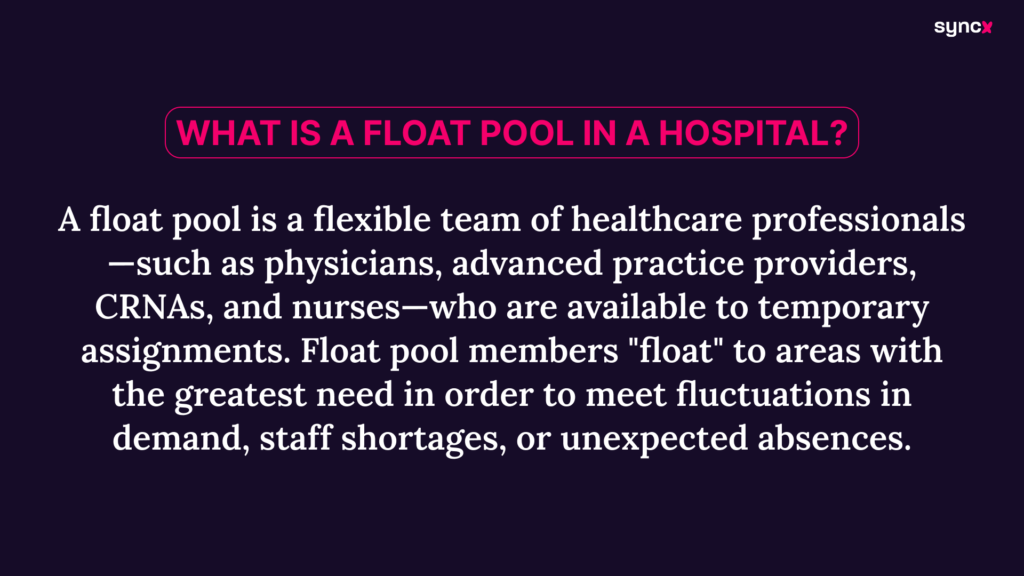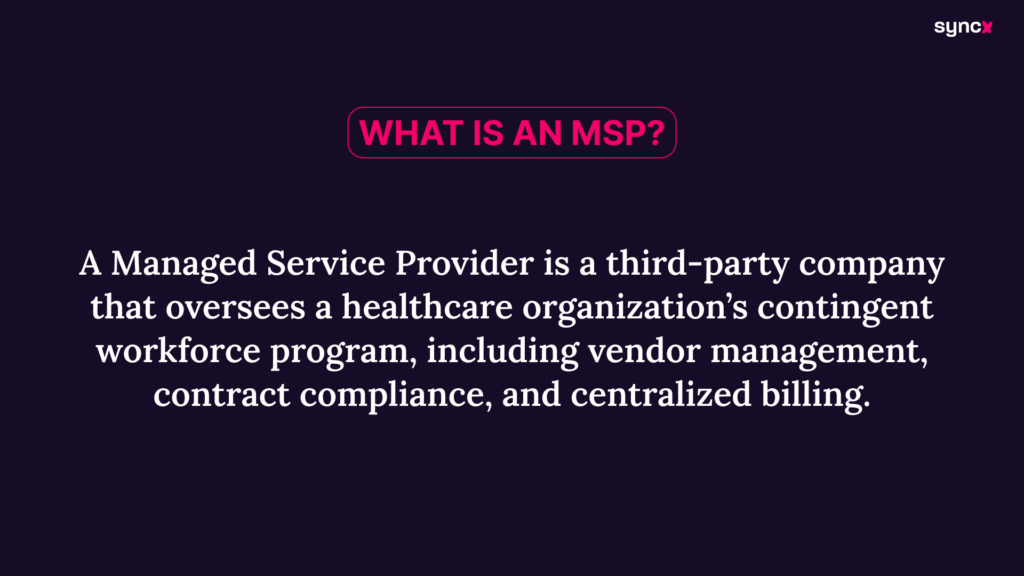As healthcare staffing pros, we know all too well how the industry relies on precise terminology to navigate workforce solutions, compliance requirements, and operational workflows. Whether you’re a hiring manager, recruiter, clinician, or healthcare administrator, keeping track of these terms on the regular will help with clarity across your contracts, credentialing, billing, and staffing strategies.
Our glossary defines key concepts—from credentialing and locum tenens to VMS platforms and modifiers—to give you a foundation for effective communication in temporary, permanent, and contingent workforce management. Feel free to use it as a reference (we do!) to streamline collaboration between healthcare facilities, staffing agencies, and providers.
Agency-Owned (MSP)
A staffing management model in which the MSP primarily or exclusively uses its own internal agency resources to fill the majority of client requests. While outside agencies may be included, they typically receive a smaller share of the business. This model is designed to maximize control, consistency, and margin retention for the MSP by leveraging its own recruiting teams first before engaging other agency partners. It is distinct from a vendor neutral MSP.
Agency Partner
A third-party staffing agency that works with an MSP to supply providers as part of a broader network. These partners are managed under a vendor management program (or some equivalent) to ensure consistent quality, compliance, and rate control on behalf of the client.
ATS (Applicant Tracking System)
A technology platform used to manage the full recruitment and placement lifecycle of healthcare providers. An ATS tracks candidate profiles, CVs, credentialing status, communications, availability, and assignment details to support recruiting and operational workflows.
Bill Rate
The hourly or daily rate a healthcare facility is charged by a staffing agency for a temporary worker (e.g., nurse, therapist, or locum tenens provider). Typically includes the worker’s pay, agency fees, and additional costs like malpractice insurance.
Confirmation
The stage when a provider is officially booked for an assignment after the client reviews and accepts the provider’s submission, and the provider agrees to the assignment details, including schedule, rate, and terms. A confirmation often triggers the credentialing and onboarding process.
Credentialing
The process of verifying a healthcare provider’s qualifications (licenses, certifications, education, work history) to ensure they meet regulatory and facility-specific standards before granting clinical privileges or employment.
CV (Curriculum Vitae)
A detailed summary of a provider’s professional background, including education, licensure, certifications, clinical experience, and work history. This is the core document used in the presentation/submission process to introduce the provider to the client.
Direct Hire
Also known as a contract buyout or conversion, a direct hire is a permanent employment arrangement where a healthcare professional is hired directly by a facility (e.g., hospital, clinic) without a temporary or contract period. Staffing agencies may assist in recruitment for a permanent placement fee.
Float Pool
A group of healthcare staff (typically nurses, physicians, advanced practice providers, and CRNAs) employed by a hospital or health system to work across multiple units or departments as needed. Float pool workers provide flexibility to cover staffing shortages, peak demand, or unexpected absences.

Internal Agency
An in-house staffing model where healthcare systems employ their own pool of temporary or per diem workers (e.g., nurses, physicians, advanced practice providers, and CRNAs) to fill shifts, reducing reliance on external staffing agencies. Often offers more stability than traditional agency work while maintaining schedule flexibility.
Internal Locums
Another name for a float pool. You may hear them used interchangeably.
Invoice Dispute
A variance between a healthcare facility and a staffing agency (or vendor) over billing charges, such as incorrect hours logged, unauthorized overtime, or discrepancies in agreed-upon rates. Typically resolved through documentation review and contract terms.
Job Order
A formal request submitted by a healthcare facility to a staffing agency or float pool, outlining details of a needed position (e.g., role, shift, duration, specialty requirements). Serves as the foundation for recruiting and placing temporary or permanent candidates.
Locum Tenens
Latin for “to hold the place of,” this phrase refers to temporary healthcare providers (e.g., physicians, NPs, APPs, etc.) who fill short-term vacancies caused by leaves, vacancies, or seasonal demand. Commonly used in hospitals, clinics, and rural areas with provider shortages.

Malpractice (or Professional Liability Insurance)
Insurance coverage provided to protect healthcare providers and clients against claims of medical negligence or errors. Syncx ensures providers have adequate malpractice coverage, often arranged through the agency or MSP agreement, to meet client requirements.
Master Services Agreement (MSA)
The formal, legally binding contract that governs the relationship between Syncx and the client under an MSP model. The MSA outlines final pricing, service levels, responsibilities, legal protections, and other binding terms that have typically been previewed in the Term Sheet. It serves as the foundation for all ongoing services provided under the MSP partnership.
MSP (Managed Service Provider)
A third-party company that oversees a healthcare organization’s contingent workforce program, including vendor management, contract compliance, centralized billing, and credentialing enablement. MSPs streamline temporary staffing by managing multiple agencies under one contract to create visibility, streamline workflows, ensure quality, and improve deliverability. While VMS is a technology, MSP are the people who handle the rest.

NALTO (National Association of Locum Tenens Organizations)
The industry association that establishes best practices, ethical standards, and guidelines for locum tenens agencies. Membership in NALTO signals adherence to professional and ethical business practices in the locum tenens industry..
Name Clear
The process of submitting a provider’s name to a client for approval before proceeding with a formal presentation. This ensures the provider isn’t already in the client’s system through another agency or direct recruitment channel, avoiding duplication or conflict.
Net Promoter Score (NPS)
A customer loyalty and satisfaction metric that measures how likely clients, providers, or partners are to recommend Syncx to others. NPS is based on a single survey question asking respondents to rate their likelihood on a scale of 0 to 10. Scores are calculated by subtracting the percentage of detractors (0-6) from the percentage of promoters (9-10). The higher the score, the better the customer loyalty and satisfaction. NPS is widely used to benchmark customer experience and identify areas for improvement.
NPI (National Provider Identifier)
A unique 10-digit number issued by the Centers for Medicare & Medicaid Services (CMS) to identify healthcare providers in standard transactions like billing and credentialing. Required for all HIPAA-covered providers in the U.S.
Per Diem
(Latin for “by the day”) Staff who work on an as-needed basis without a guaranteed schedule, often filling last-minute shifts. Common in nursing and allied health. Per diem roles typically offer higher hourly wages but lack benefits or guaranteed hours.
Presentation (or Submission)
The formal step where a provider’s CV, credentialing details, and other relevant information are submitted to the client for review after name clear. This is typically the point when the provider becomes officially under consideration for an open assignment.
PRN (Pro Re Nata)
(Latin for “as the situation demands”) Similar to per diem, PRN staff work only when needed, often for short-term coverage or fluctuating patient volumes.
Privileging
The formal process by which a healthcare facility grants a licensed provider (e.g., physician, nurse practitioner) permission to perform specific procedures or services within that institution. Separate from credentialing, which verifies baseline qualifications.
Q6 Modifier
A billing code used in Medicare claims to identify services provided by a locum tenens physician. It allows a substitute doctor to bill under the absent provider’s NPI for up to 60 continuous days, ensuring payment continuity while maintaining compliance.
RPO (Recruitment Process Outsourcing)
A form of staffing partnership where an external firm assumes all or part of a healthcare organization’s hiring processes (sourcing, screening, onboarding). Unlike traditional agencies, RPO providers act as an extension of the internal HR team, often for long-term engagements.
Stipend
A fixed, agreed-upon amount paid to the provider in addition to or in lieu of hourly/shift-based pay. It may cover travel, lodging, or other expenses. Stipends are typically negotiated as part of the provider’s overall compensation package for an assignment.
Term Sheet (MSP)
A pre-contract summary document that outlines the key commercial and operational terms of a potential Managed Service Provider (MSP) agreement. It typically covers pricing, scope of services, implementation timeline, and client-specific requirements. The term sheet serves as the basis for drafting the Master Services Agreement (MSA) or MSP Agreement, ensuring both parties are aligned on major terms before formal contract negotiations begin.
Travel Nurse
A licensed nurse who works short-term contracts (typically 8–26 weeks) at healthcare facilities across regions, often to address staffing shortages. Travel nurses usually receive housing stipends, travel reimbursements, and competitive pay in exchange for location flexibility.
Vendor Neutral (MSP)
A staffing management approach in which the MSP does not favor its own recruiting team or affiliated agencies over other agency partners in filling client needs. In a vendor-neutral model, all agencies, including the MSP’s internal sourcing team if applicable, compete on equal terms to fill open requests. This model is designed to promote fairness, maximize fill rates, drive competitive pricing, and ensure the client receives the best possible candidates, regardless of source.
VMS (Vendor Management System)
A technology platform used by healthcare organizations to manage and procure contingent labor (e.g., temp nurses, locum tenens). Features include vendor selection, shift scheduling, time tracking, and invoicing, often integrated with MSP programs.

More Hires, Less Spend—Guaranteed Efficiency
If there’s one definition for us here at Syncx, it’s “delivering maximum impact.” So if you’re tired of overpaying for locums while struggling with slow fills, we’re here for you. Literally — we’re here exactly because we’ve seen too many hospitals go exactly through the same thing. That’s why we designed our Syncx MSP to deliver both sides of the fair pay/fast fill equation.
What could be the definition of our partnership?
✅ 20-30% cost reduction below your current locums spend
✅ Real-time placements via competitive agency marketplace
✅ Automated admin so you spend less time on paperwork
Book your demo today and find out what a vendor neutral partnership can do for you!
